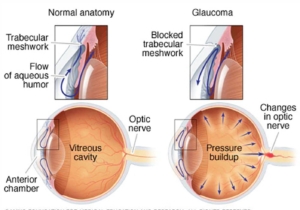Glaucoma is a leading cause of blindness for people over 60 years old. Unfortunately only about half of the people who have glaucoma even know they have it. This is because it has no early symptoms.Eye doctors sometimes call it the “sneak thief of vision”.
Glaucoma is a disease that damages the optic nerve: this nerve is responsible for sending visual messages from your eye to your brain. Glaucoma typically happens when the fluid in the eye does not drain as it should. The fluid gradually builds up and increases pressure in the eye. That pressure is what damages the optic nerve.
Blindness from glaucoma can often be prevented with early treatment. Treating glaucoma won’t bring back any vision that has been lost but it can help save the sight one still has. In the healthy eye fluid called aqueous humour is made in the front of the eye and flows out through a tiny drain called the trabecular meshwork. The trabecular meshwork is located in an area called the drainage angle. If fluid doesn’t flow out of the drainage angle properly eye pressure increases and damages the optic nerve.
There are several types of glaucoma but the most common form is called primary open-angle glaucoma. This type occurs when the trabecular meshwork of the eye gradually becomes less effective at draining fluid. As this happens, eye pressure rises leading to damage of the optic nerve. As more optic nerve damage occurs, blank spots begin to appear in the field of vision. It’s hard to notice these blank spots in day-to-day life until the optic nerve is significantly damaged and the spots become large. If the optic nerve is severely damaged that eye will go blind. Eye pressure rises and falls from day today and hour to hour. Therefore a single eye pressure test may not detect glaucoma in some people who actually have the disease. This is why it is very important to see your ophthalmologist regularly. He or she will monitor your eye pressure, examine your optic nerve and check for any vision loss that may have occurred.
There is no single normal eye pressure number that applies to everyone. Optic nerve damage can happen at different eye pressures in different people. Treatment If your ophthalmologist determines that you have glaucoma or feels you are at risk of developing the disease he or she will establish a target eye pressure specifically for you. That target pressure is to protect your optic nerve from damage.
There are several ways to treat glaucoma depending on the type you have and how far it has progressed. The most common way is with eye-drop medication. These medications lower eye pressure in one of two ways: they either reduce the amount of fluid produced by the eye or they help this fluid flow out of the eye through the drainage angle. Glaucoma eye drops must be taken every day as prescribed by your ophthalmologist. Surgery may be recommended for some people with glaucoma. Glaucoma surgery improves the flow of fluid out of the eye helping to lower eye pressure. Treating glaucoma is important for preserving vision and quality of life.
If you have any questions or concerns about your eyes or your vision in general don’t hesitate to bring them up. Your ophthalmologist is committed to protecting your sight!


